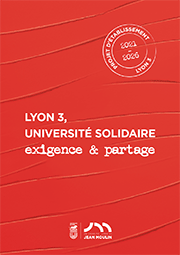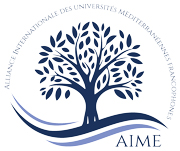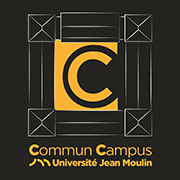AccueilRechercheProgrammes et productions scientifiquesThèsesThèses soutenuesThèses soutenues - 2006-2021Thèses soutenues - 2017
-
Partager cette page
- Recherche,
BIKTCHOURINA Angelina
Les verbes gnat’ / gonjat’ : sémantique, catégorie grammaticale, dérivation et phraséologie
Publié le 6 juillet 2017 – Mis à jour le 3 octobre 2017
Thèse en Cultures et Sociétés en Europe, soutenue le 30 juin 2017.
Dans cette thèse, nous avons étudié d’une manière structurée et détaillée la sémantique des verbes gnat’ et gonjat’. Pour cela, nous avons tout d’abord formalisé leur potentiel sémantique qui comprend les composants de leur valeur de base et ce qu’ils génèrent dans des situations nouvelles, dans des cotextes particuliers. Pour chaque valeur sémantique, nous avons présenté un schéma sémantique, un schéma actantiel en précisant les r?les sémantiques, la nature des actants et leur réalisation syntaxique, ainsi que des illustrations d’emploi dans des cotextes des plus représentatifs, des synonymes, la famille morphologique. Les valeurs plus ou moins communes à gnat’ et à gonjat’ ont été étudiées ensemble, ce qui nous a permis de mettre en évidence leurs similitudes et différences. Puis, nous avons traité la question de la catégorie grammaticale des verbes de mouvement. Après avoir exposé les propriétés traditionnellement attribuées aux corrélats déterminé / indéterminé et les particularités qui sont générées dans l’emploi de chacun de ces corrélats, nous avons analysé la corrélation déterminé / indéterminé en général, et en particulier, entre gnat’ et gonjat’. Faisant partie de la catégorie grammaticale des verbes de mouvement, gnat’ et gonjat’ s’opposent sur le plan grammatical en tant que déterminé vs indéterminé et leurs caractéristiques grammaticales induisent quelques différences sémantiques. Ainsi, la plupart des différences observées entre gnat’ et gonjat’ ne sont pas en fait pas d’ordre lexical, mais résultent des différences grammaticales du déterminé gnat’ et de l’indéterminé gonjat’. Dans la partie consacrée à la dérivation morphologique, nous avons eu pour objectif d’examiner les effets de la préverbation et les modifications de sens que la préverbation entra?ne pour ces verbes. Nous avons étudié les préverbés formés sur la base de gnat’ / gonjat’ à valeur spatiale en les regroupant en fonction de l’orientation spatiale : à partir du point de départ, vers le point d’arrivée, les deux en même temps ou en rapport avec un repère. Une attention minutieuse a été accordée aux différences sémantiques et aspectuelles de certains préverbés partageant les mêmes valeurs spatiales. L’étude des préverbés combinés aux préverbes à valeur non spatiale a été organisée en fonction de la morphologie de l’aspect : les préverbés hors couple et les couples de verbes. Quelques particularités ont été observées. Pour que l’étude sémantique soit complète, nous y avons inclus la question des phrasèmes comportant ces verbes. Puis, nous avons analysé le parallélisme qui existe entre gnat’ / gonjat’ simples et préverbés et le verbe dit de position sidet’ : les valeurs que ces verbes ont en commun et aussi, les limites de leur corrélation, Enfin, en partant directement des situations linguistiques concrètes avec gnat’ / gonjat’ simples et préverbés nous avons exposé un certain nombre de mécanismes qui aboutissent à un effet expressif.
In this thesis, we have studied the semantics of the verbs gnat’ and gonjat’ in a structured and extensive way. To achieve this, we began by structuring their semantic potential, which includes their basic value and what it produces in new situations, in specific cotexts. For each semantic value, we have presented a semantic schema, mapping the semantic roles of the actants, their nature and their syntactic development, together with examples of usage in the most representative cotexts, the synonyms, the morphological family. The more or less common values of gnat’ and gonjat’ have been studied together, so that we could bring their similarities and differences to light. Then, we dealt with the question of the grammatical category of the verbs of motion. Having presented the usually attributed properties of the correlate determined / indetermined and the particularities that emerge in the usage of each of these correlates, we have focused on the determined / indetermined correlation in general and between gnat’ and gonjat’ in particular. While belonging to the same grammatical category of the verbs of motion, both gnat’ and gonjat’ are opposed on a grammatical level, as determined and indetermined, and their grammatical characteristics lead to some semantical differences. Hence, most of the observed differences between gnat’ and gonjat’ are not of a lexical type; they are rather the result of the semantical differences between the determined gnat’ and the indetermined gonjat’. In the part of our thesis dedicated to morphological derivation, our goal was to study the impacts of verbal prefixation and the change of meaning as a result of the prefixation for these verbs. We have studied prefixed verbs based on gnat’ / gonjat’ with spatial meanings, clustering them depending on their spatial orientation: from the starting point, to the point of arrival, both at the same time or in relation to a landmark. A particular focus has been placed on the semantical and aspectual differences of some verbs with prefixes that share the same spatial values. The analysis of verbs with spatial prefixes was done according to the morphology of the aspect: the verbs with prefixes outside aspectual pairs and the pair of verbs. Some particularities have been observed. For the semantic study to be complete, we have added the question of the phrasemes using these verbs. Then, we studied the similarity between gnat’ and gonjat’ in their simple and prefixed forms and the verb of position sidet’: what those verbs have in common but also the limits of their similarities. Finally, we have taken concrete linguistic situations involving gnat’ and gonjat’ in their simple and prefixed forms in order to outline a number of mechanisms leading to an expressive result.
Mots-clés :
linguistique russe, gnat’ / gonjat’, sémantique, actant, agentivité, patientivité, contrainte, résistance, catégorie grammaticale, verbes de mouvement, corrélation déterminé / indéterminé, orientation spatiale, dérivation, préverbation, préverbes, phraséologie, phrasème, collocations, locutions, sidet’, expressivité.
Keywords :
Russian linguistics, gnat’/ gonjat’, semantics, actant, agentivity, patientivity constraint, resistance, grammatical category, verbs of motion, determined / indetermined correlation, spatial orientation, derivation, verb prefixation, prefixes, phraseology, phraseme, collocations, idioms, sidet’, expressive power.
Directeur(s).trice(s) de thèse : M. Robert ROUDET
In this thesis, we have studied the semantics of the verbs gnat’ and gonjat’ in a structured and extensive way. To achieve this, we began by structuring their semantic potential, which includes their basic value and what it produces in new situations, in specific cotexts. For each semantic value, we have presented a semantic schema, mapping the semantic roles of the actants, their nature and their syntactic development, together with examples of usage in the most representative cotexts, the synonyms, the morphological family. The more or less common values of gnat’ and gonjat’ have been studied together, so that we could bring their similarities and differences to light. Then, we dealt with the question of the grammatical category of the verbs of motion. Having presented the usually attributed properties of the correlate determined / indetermined and the particularities that emerge in the usage of each of these correlates, we have focused on the determined / indetermined correlation in general and between gnat’ and gonjat’ in particular. While belonging to the same grammatical category of the verbs of motion, both gnat’ and gonjat’ are opposed on a grammatical level, as determined and indetermined, and their grammatical characteristics lead to some semantical differences. Hence, most of the observed differences between gnat’ and gonjat’ are not of a lexical type; they are rather the result of the semantical differences between the determined gnat’ and the indetermined gonjat’. In the part of our thesis dedicated to morphological derivation, our goal was to study the impacts of verbal prefixation and the change of meaning as a result of the prefixation for these verbs. We have studied prefixed verbs based on gnat’ / gonjat’ with spatial meanings, clustering them depending on their spatial orientation: from the starting point, to the point of arrival, both at the same time or in relation to a landmark. A particular focus has been placed on the semantical and aspectual differences of some verbs with prefixes that share the same spatial values. The analysis of verbs with spatial prefixes was done according to the morphology of the aspect: the verbs with prefixes outside aspectual pairs and the pair of verbs. Some particularities have been observed. For the semantic study to be complete, we have added the question of the phrasemes using these verbs. Then, we studied the similarity between gnat’ and gonjat’ in their simple and prefixed forms and the verb of position sidet’: what those verbs have in common but also the limits of their similarities. Finally, we have taken concrete linguistic situations involving gnat’ and gonjat’ in their simple and prefixed forms in order to outline a number of mechanisms leading to an expressive result.
Mots-clés :
linguistique russe, gnat’ / gonjat’, sémantique, actant, agentivité, patientivité, contrainte, résistance, catégorie grammaticale, verbes de mouvement, corrélation déterminé / indéterminé, orientation spatiale, dérivation, préverbation, préverbes, phraséologie, phrasème, collocations, locutions, sidet’, expressivité.
Keywords :
Russian linguistics, gnat’/ gonjat’, semantics, actant, agentivity, patientivity constraint, resistance, grammatical category, verbs of motion, determined / indetermined correlation, spatial orientation, derivation, verb prefixation, prefixes, phraseology, phraseme, collocations, idioms, sidet’, expressive power.
Directeur(s).trice(s) de thèse : M. Robert ROUDET
Membres du jury :
Vladimir BELIAKOV, Professeur des universités, Université Toulouse - Jean Jaurès,
Tatiana BOTTINEAU, Professeure des universités, INALCO, Paris,
Irina KOR CHAHINE, Professeure des universités, Université Nice Sophia Antipolis,
Robert ROUDET, Professeur des universités, Université Jean Moulin Lyon 3.
Président.e du jury : M. Vladimir BELIAKOV
Equipe d'accueil : CEL
Tatiana BOTTINEAU, Professeure des universités, INALCO, Paris,
Irina KOR CHAHINE, Professeure des universités, Université Nice Sophia Antipolis,
Robert ROUDET, Professeur des universités, Université Jean Moulin Lyon 3.
Président.e du jury : M. Vladimir BELIAKOV
Equipe d'accueil : CEL
Décision : Admise
Documentation
Mise à jour : 3 octobre 2017







